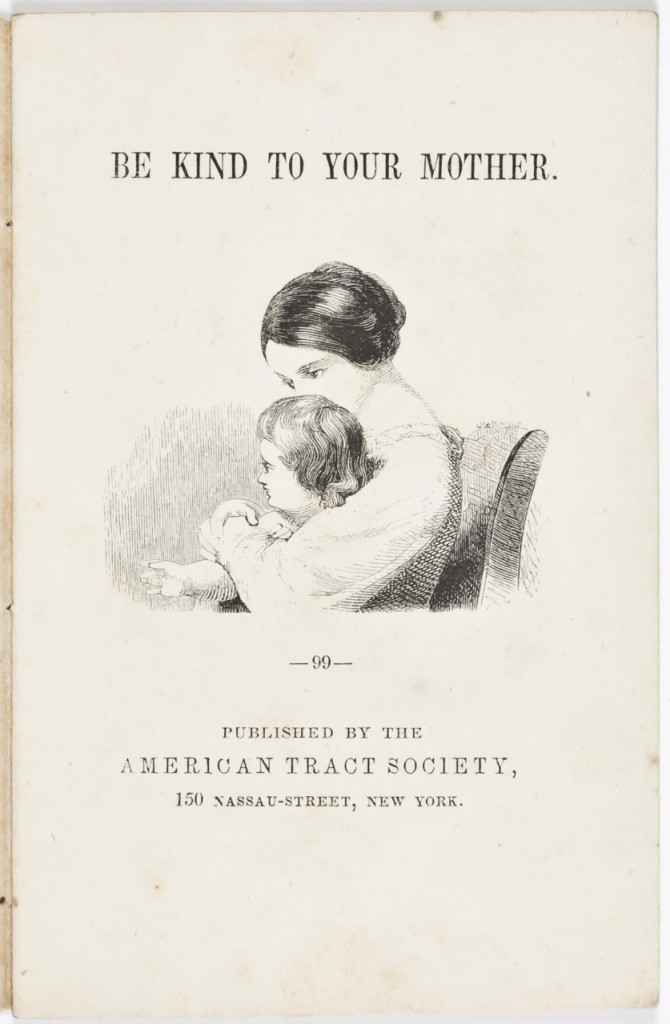Candace Ruby is a senior history major at Assumption College and currently interns in the AAS Readers’ Services Department.
“Were we to select the dearest and most responsible of all relations in this fallen world, it would be that of a mother.” –The Mother’s Manual, : Containing Practical Hints, by a Mother
As Mother’s Day approaches, it is time to reflect on all that our mothers have done for us over the years. They raised us, they taught us right and wrong, and they sacrificed for us more than they would care to admit. While the annual holiday of Mother’s Day is a rather new phenomenon (only being recognized as a national holiday in 1914), the concept of expressing respect and honoring one’s mother has deep roots in antiquity. Many ancient civilizations  possessed some concept of a mother goddess: the Greeks worshipped the mother goddess Cybele, the Egyptians with the goddess Hathor, the Aztecs with Toci, and Hinduism with Durga. The American tradition, however, is more rooted in Christian doctrine, namely the Old Testament and the Ten Commandments. It was a parent’s Christian duty to teach the Bible to his or her children, and children were expected to follow the rules set out for them and live life as a “good Christian.”
possessed some concept of a mother goddess: the Greeks worshipped the mother goddess Cybele, the Egyptians with the goddess Hathor, the Aztecs with Toci, and Hinduism with Durga. The American tradition, however, is more rooted in Christian doctrine, namely the Old Testament and the Ten Commandments. It was a parent’s Christian duty to teach the Bible to his or her children, and children were expected to follow the rules set out for them and live life as a “good Christian.”
Early American literature does much to encourage this behavior, with titles such as Be Kind to Your Mother and How to Help and Comfort Your Mother within AAS’s collection of children’s literature. How to Help and Comfort Your Mother, published by the Mass. Sabbath School Society in 1836, urges children to help their mother whenever she needs it: “When you see that she is very busy, you must not give her your ball to fix, or doll to dress. You must be ready to go up stairs or down stairs for her, or do any thing that she may want you to do.” Mothers in particular were responsible for the nurturing and the instruction of their children, especially regarding prayer and Christian teachings. All good children were expected to honor both of their parents and to do something every day to help them. How to Help and Comfort Your Mother urges children: “Begin early ; see to-day and to-morrow, and next day, and every day of your life, in how many ways you can be a help and comfort to your mother.”
 The desire for an annual appreciation of mothers led to the conception and celebration of the first “Mother’s Day” in the early twentieth century. The American holiday of Mother’s Day was first conceived by Anna Jarvis upon the death of her mother in 1905. She wished to memorialize her own mother, who had worked as a peace activist during the American Civil War, as well as recognize all mothers for their caring and compassion. The first celebration of Mother’s Day occurred in 1908 in Grafton, West Virginia, when Jarvis held a memorial for her mother. In 1910, West Virginia became the first state to recognize Mother’s Day as a holiday and in 1914, President Woodrow Wilson signed the proclamation that declared Mother’s Day to be a national holiday, which would be celebrated on the second Sunday in May. Since its creation in 1914, Mother’s Day has become one of the most popular holidays and is now celebrated all over the world.
The desire for an annual appreciation of mothers led to the conception and celebration of the first “Mother’s Day” in the early twentieth century. The American holiday of Mother’s Day was first conceived by Anna Jarvis upon the death of her mother in 1905. She wished to memorialize her own mother, who had worked as a peace activist during the American Civil War, as well as recognize all mothers for their caring and compassion. The first celebration of Mother’s Day occurred in 1908 in Grafton, West Virginia, when Jarvis held a memorial for her mother. In 1910, West Virginia became the first state to recognize Mother’s Day as a holiday and in 1914, President Woodrow Wilson signed the proclamation that declared Mother’s Day to be a national holiday, which would be celebrated on the second Sunday in May. Since its creation in 1914, Mother’s Day has become one of the most popular holidays and is now celebrated all over the world.
So as this holiday approaches, take time out of your busy schedule to visit your mother, or call her to express your gratitude for all that she has done. If she has already passed, take a moment to reflect on some moments that the two of you have shared. For indeed, as Washington Irving once wrote, “A mother is the truest friend we have.”
